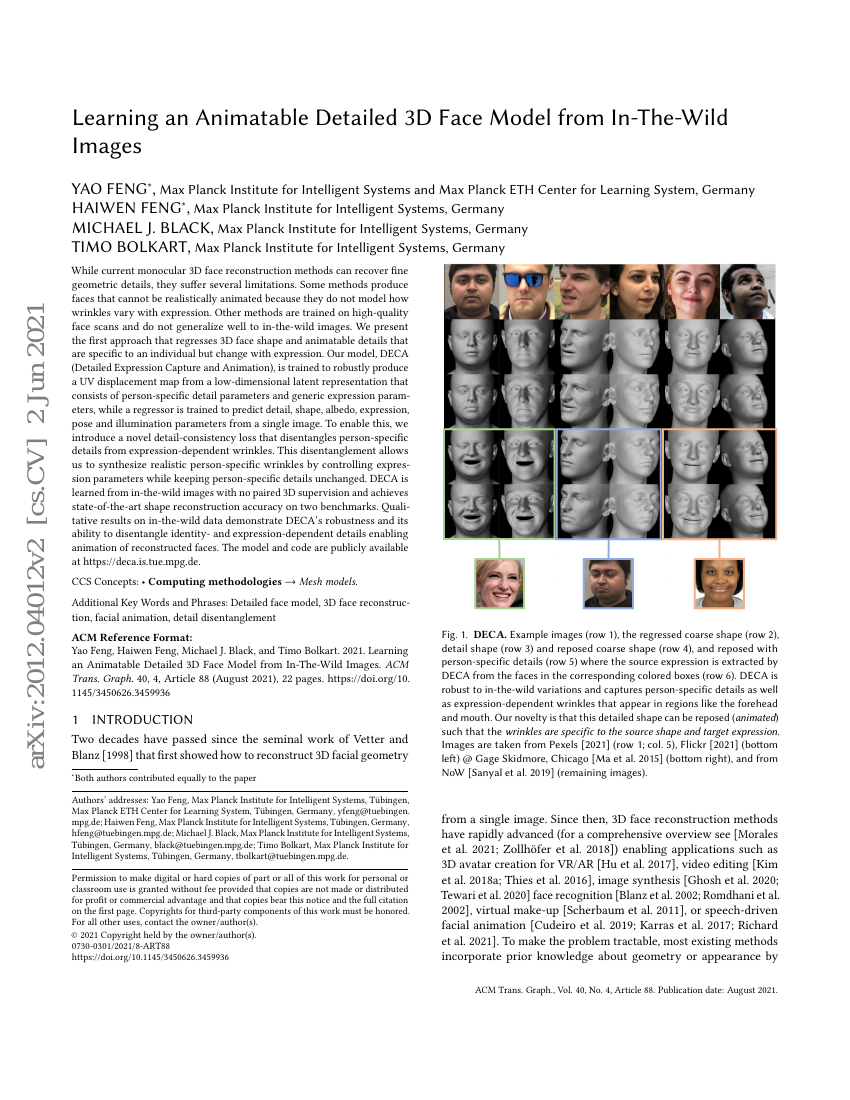
摘要
当前的单目3D人脸重建方法虽然能够恢复精细的几何细节,但仍存在若干局限性。一些方法生成的人脸无法进行逼真的动画处理,因为它们没有建模皱纹随表情变化的情况。其他方法则是在高质量的人脸扫描数据上训练的,因此在处理野外图像时泛化能力较差。本文提出了一种新的方法,首次实现了从单个图像中回归出特定个体的3D人脸形状及其随表情变化的可动画细节。我们的模型DECA(Detailed Expression Capture and Animation)经过训练,可以从低维潜在表示中稳健地生成UV位移图,该潜在表示由个体特有细节参数和通用表情参数组成;同时,一个回归器被训练用于从单张图像预测细节、形状、反照率、表情、姿态和光照参数。为此,我们引入了一种新颖的细节一致性损失函数,该函数能够将个体特有细节与表情相关的皱纹区分开来。这种区分使得我们能够在保持个体特有细节不变的情况下,通过控制表情参数合成逼真的个体特有皱纹。DECA模型无需配对的3D监督数据即可从野外图像中学习,并在两个基准测试中达到了最先进的形状重建精度。在野外数据上的定性结果展示了DECA的鲁棒性和其分离身份相关和表情相关细节的能力,从而实现重建人脸的动画处理。该模型及代码已公开发布于https://deca.is.tue.mpg.de。
代码仓库
YadiraF/DECA
官方
pytorch
GitHub 中提及
yfeng95/deca
pytorch
GitHub 中提及
基准测试
| 基准 | 方法 | 指标 |
|---|---|---|
| 3d-face-reconstruction-on-now-benchmark-1 | DECA | Mean Reconstruction Error (mm): 1.38 Median Reconstruction Error: 1.09 Stdev Reconstruction Error (mm): 1.18 |
| 3d-face-reconstruction-on-realy | DECA-f | @cheek: 1.443 (±0.498) @forehead: 2.457 (±0.559) @mouth: 2.802 (±0.868) @nose: 2.138 (±0.461) all: 2.210 |
| 3d-face-reconstruction-on-realy | DECA-c | @cheek: 1.479 (±0.535) @forehead: 2.394 (±0.576) @mouth: 2.516 (±0.839) @nose: 1.697 (±0.355) all: 2.010 |
| 3d-face-reconstruction-on-realy-side-view | DECA-f | @cheek: 1.555 (±0.822) @forehead: 2.519 (±0.718) @mouth: 2.684 (±1.041) @nose: 2.286 (±1.103) all: 2.261 |
| 3d-face-reconstruction-on-realy-side-view | DECA-c | @cheek: 1.630 (±1.135) @forehead: 2.423 (±0.720) @mouth: 2.472 (±1.079) @nose: 1.903 (±1.050) all: 2.107 |
| 3d-face-reconstruction-on-stirling-hq-fg2018 | DECA | Mean Reconstruction Error (mm): 1.89 |
| 3d-face-reconstruction-on-stirling-lq-fg2018 | DECA | Mean Reconstruction Error (mm): 1.91 |